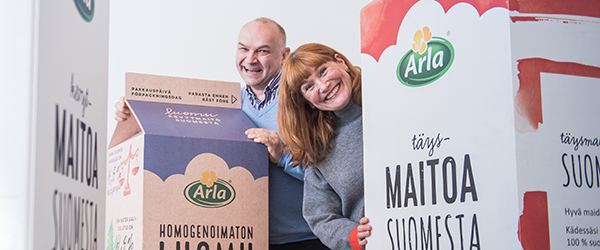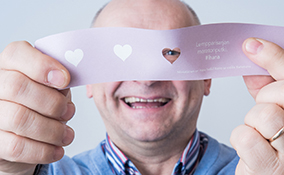Arla’s packaging is getting greener and smarter

Product safety is always the first criterion when choosing packaging materials and solutions for dairy products.
– This is due to the hygiene requirements and the fact that the product has to remain usable until its best before date, says Sampo Isokoski, who is responsible for packaging design at Arla.
Arla’s dairy in Sipoo packs about half of the products that the company sells in Finland. These include all milk products and a large proportion of yoghurt products and cooking ingredients that are packed in various cartons, plastic cups and also plastic cups covered with carton sleeves, which contain less plastic thanks to the sleeve. The cups usually come with an aluminium foil lid.
All in all, about 300 million containers are used for packing Arla’s dairy products in Finland every year. Product safety is the top priority in every one of them.
– Milk is a particularly delicate and demanding product, says Sanna Heikfolk, Brand and Category Manager at Arla.
If a container’s protective characteristics are not up to standard, it is easy to detect flavour and odour defects in a milk product even if it’s still usable.
Eco-friendliness is a growing trend
In food packaging, the trend is towards biodegradable, renewable materials and reduced levels of carbon dioxide emissions and plastics.
Companies avoid over-packing their products and focus on reusable packaging and recyclable packaging materials. In addition, efforts are made to manufacture thinner and lighter cartons without sacrificing product safety. However, bringing a new material into production takes time.
– When we think about introducing a new packaging material for a product, it takes 12 to 18 months before it’s available to consumers. Materials go through long shelf-life tests and they are thoroughly tested in the production line, Isokoski explains.
Environmental aspects are also taken into account, and we work closely with suppliers of materials.
– We demand that they adhere to the principles of ethics and corporate responsibility, which is ensured by various agreements. This way we can guarantee that the entire chain is in line with our values and responsibility principles.
Arla launched its ecological, brown packaging for organic milk in October.
– In terms of eco-friendliness, nothing new has happened with milk containers for a while, so we are pioneers with this feature, says Heikfolk.
Product safety was first to be tested, after which we moved on to examine the packaging’s eco-friendliness. The packaging manufacturer Elopak produces a material in which the plastic layers are also made of renewable materials. The outermost carton is not bleached, so one step in the process was completely eliminated.
– Compared to a standard milk carton, our organic milk carton is 4.8 per cent lighter, and its carbon footprint is 33 per cent lower.
The new carton has been on the market for a few months, so we have already received some feedback from consumers.
– So far, it has been positive, and sales have even gone up since the brown packaging was launched, says Heikfolk, clearly delighted.
Some consumers may be confused by the brown packaging at first because white packaging is so strongly associated with the milk product category.
– We had already introduced this feature to consumers as a number of our milk cartons have had a brown interior surface for quite some time. It also lets less light through and protects the product better than a carton that is completely white.
The new packaging of organic milk was, according to Heikfolk, a first for Arla.
– Now we are thinking about what other products we could pack in more ecological packaging.
Communication on the media surface
– Consumers talk about blue or red milk for skimmed and full-fat milk, respectively. This also guides the design: red should not be used on skimmed milk cartons. You can put wilder ideas into practice on other products.
– For example, the Ihana Greek Style yoghurt cup has a heart-shaped opening so that you can see the product. The idea was implemented really well, and it was guided by the design, Sampo Isokoski explains.
The Ihana range of yoghurt cups also have a removable carton sleeve that can be recycled separately. Thanks to the sleeve, the plastic is thinner, which makes it more environmentally friendly.
Arla has added augmented reality on the packaging of the standard milk range. The mobile app features Aamu the cat, an interactive character that does different things at different times of the day.
– We believe that products and their packaging must always show something new. When we were developing Aamu the cat, we thought about how we could cheer up our customers, says Heikfolk.
It’s a pilot project that will help us to understand the contexts where augmented reality could be used.
– It’s an excellent and environmentally friendly way to communicate with consumers. There’s no need to print any special material on the packaging.
Change is permanent
According to Sampo Isokoski, the packaging sector is always developing, and various types of packaging and materials are being launched on the market at an accelerating pace. Printing technology is also evolving, and packaging structures are changing.
– You have to keep up with the changes. This requires a variety of experiments, many of which consumers are never aware of.
The retail sector also has ideas of how packaging could improve the shelf image or how products could be made to stand out.
– Companies must keep track of the latest developments so that consumers are able to find their products effortlessly, says Isokoski.
Less waste
In Finland, huge amounts of milk are packed in recyclable plastic boxes and metal roller cages.
– The boxes and roller cages are returned to dairies from shops so that they can be reused, which reduces the amount of packaging waste, says Sampo Isokoski.
Arla packs its yoghurt cups and butter tubs in corrugated cardboard boxes. Isokoski says that shops are increasingly using the packaging as a store display unit. Transport containers made of cardboard also allow for smaller batches, which are useful in smaller shops.
– Different types of opening options are designed for transport packaging so that products look attractive in them. Last year, for example, we had 16 different transport packaging development projects running at the same time, says Isokoski.
The size of consumer packaging can also reduce waste. The most common milk carton size, one litre, is the largest in volume.
– Smaller consumer packaging reduces waste when there is need for on-the-go packaging or if different versions of the same product are used in a household for reasons such as food sensitivity, Sanna Heikfolk clarifies.
28.2.2018
Text Susanna Haanpää
Photos Vesa Tyni
